Colombian Crop Resilience: Evaluating National Yield Stability for Fruit and Vegetable Systems
Abstract
:1. Introduction
2. Materials and Methods
2.1. Description of the Database and the Collected Information
2.2. Description of Agricultural Productivity for Fruits and Vegetables in Colombia
2.3. Evaluation of the Crop Yields to Analyze Agricultural Systems Stability
2.4. Analysis of Non-Climatic Factors on Agricultural Productivity among Colombian Regions
2.5. Conceptual Framework Applied in the Study
3. Results
3.1. Decreases of Fruits and Vegetables Yield in Colombia
3.2. Local Production of Fruits and Vegetables in Colombia
3.3. Yield Evaluation and the Impact of Non-Climate Factors on the Agricultural Systems
4. Discussion
5. Conclusions
Supplementary Materials
Author Contributions
Funding
Institutional Review Board Statement
Data Availability Statement
Conflicts of Interest
References
- Legiscomex Cifras de Comercio Exterior y Acuerdos Comerciales. Available online: http://www.legiscomex.com (accessed on 20 January 2023).
- DANE. Boletín Estadístico Sectorial Agropecuario 2022. Available online: https://upra.gov.co/es-co/Documents/Bolet%c3%adn%20Estad%c3%adstico%20Sectorial%20Agropecuario%202022%202%5b3%5d.pdf (accessed on 29 September 2023).
- DANE. Encuestan Nacional Agropecuaria 2019. Boletín Técnico. Available online: https://www.dane.gov.co/files/investigaciones/agropecuario/enda/ena/2019/boletin_ena_2019.pdf (accessed on 29 September 2023).
- Kamble, S.S.; Gunasekaran, A.; Gawankar, S.A. Achieving Sustainable Performance in a Data-Driven Agriculture Supply Chain: A Review for Research and Applications. Int. J. Prod. Econ. 2020, 219, 179–194. [Google Scholar] [CrossRef]
- Gurgel, A.C.; Reilly, J.; Blanc, E. Challenges in Simulating Economic Effects of Climate Change on Global Agricultural Markets. Clim. Chang. 2021, 166, 29. [Google Scholar] [CrossRef]
- Dumortier, J.; Carriquiry, M.; Elobeid, A. Impact of Climate Change on Global Agricultural Markets under Different Shared Socioeconomic Pathways. Agric. Econ. 2021, 52, 963–984. [Google Scholar] [CrossRef]
- Cui, Z.; Zhang, H.; Chen, X.; Zhang, C.; Ma, W.; Huang, C.; Zhang, W.; Mi, G.; Miao, Y.; Li, X.; et al. Pursuing Sustainable Productivity with Millions of Smallholder Farmers. Nature 2018, 555, 363–366. [Google Scholar] [CrossRef] [PubMed]
- Chen, X.-P.; Cui, Z.-L.; Vitousek, P.M.; Cassman, K.G.; Matson, P.A.; Bai, J.-S.; Meng, Q.-F.; Hou, P.; Yue, S.-C.; Römheld, V.; et al. Integrated Soil–Crop System Management for Food Security. Proc. Natl. Acad. Sci. USA 2011, 108, 6399–6404. [Google Scholar] [CrossRef] [PubMed]
- Tester, M.; Langridge, P. Breeding Technologies to Increase Crop Production in a Changing World. Science 2010, 327, 818–822. [Google Scholar] [CrossRef]
- Meuwissen, M.P.M.; Feindt, P.H.; Spiegel, A.; Termeer, C.J.A.M.; Mathijs, E.; de Mey, Y.; Finger, R.; Balmann, A.; Wauters, E.; Urquhart, J.; et al. A Framework to Assess the Resilience of Farming Systems. Agric. Syst. 2019, 176, 102656. [Google Scholar] [CrossRef]
- Majumdar, J.; Naraseeyappa, S.; Ankalaki, S. Analysis of Agriculture Data Using Data Mining Techniques: Application of Big Data. J. Big Data 2017, 4, 20. [Google Scholar] [CrossRef]
- Reidsma, P.; Ewert, F.; Oude Lansink, A. Analysis of Farm Performance in Europe under Different Climatic and Management Conditions to Improve Understanding of Adaptive Capacity. Clim. Chang. 2007, 84, 403–422. [Google Scholar] [CrossRef]
- Olesen, J.E.; Trnka, M.; Kersebaum, K.C.; Skjelvåg, A.O.; Seguin, B.; Peltonen-Sainio, P.; Rossi, F.; Kozyra, J.; Micale, F. Impacts and Adaptation of European Crop Production Systems to Climate Change. Eur. J. Agron. 2011, 34, 96–112. [Google Scholar] [CrossRef]
- Challinor, A.J.; Ewert, F.; Arnold, S.; Simelton, E.; Fraser, E. Crops and Climate Change: Progress, Trends, and Challenges in Simulating Impacts and Informing Adaptation. J. Exp. Bot. 2009, 60, 2775–2789. [Google Scholar] [CrossRef] [PubMed]
- Deryng, D.; Sacks, W.J.; Barford, C.C.; Ramankutty, N. Simulating the Effects of Climate and Agricultural Management Practices on Global Crop Yield. Glob. Biogeochem. Cycles 2011, 25, GB2006. [Google Scholar] [CrossRef]
- Jiménez, D.; Cock, J.; Satizábal, H.F.; Barreto S, M.A.; Pérez-Uribe, A.; Jarvis, A.; Van Damme, P. Analysis of Andean Blackberry (Rubus Glaucus) Production Models Obtained by Means of Artificial Neural Networks Exploiting Information Collected by Small-Scale Growers in Colombia and Publicly Available Meteorological Data. Comput. Electron. Agric. 2009, 69, 198–208. [Google Scholar] [CrossRef]
- Chapagain, T.; Raizada, M.N. Agronomic Challenges and Opportunities for Smallholder Terrace Agriculture in Developing Countries. Front. Plant Sci. 2017, 8, 331. [Google Scholar] [CrossRef] [PubMed]
- Agudelo, C.; Rivera, B.; Tapasco, J.; Estrada, R. Designing Policies to Reduce Rural Poverty and Environmental Degradation in a Hillside Zone of the Colombian Andes. World Dev. 2003, 31, 1921–1931. [Google Scholar] [CrossRef]
- Camas Gómez, R.; Turrent Fernández, A.; Cortes Flores, J.I.; Livera Muñóz, M.; González Estrada, A.; Villar Sánchez, B.; López Martínez, J.; Espinoza Paz, N.; Cadena Iñiguez, P. Erosión Del Suelo, Escurrimiento y Pérdida de Nitrógeno y Fósforo En Laderas Bajo Diferentes Sistemas de Manejo En Chiapas, México. Rev. Mex. Cienc. Agric. 2018, 3, 231–243. [Google Scholar] [CrossRef]
- Devkota, R.; Pant, L.P.; Gartaula, H.N.; Patel, K.; Gauchan, D.; Hambly-Odame, H.; Thapa, B.; Raizada, M.N. Responsible Agricultural Mechanization Innovation for the Sustainable Development of Nepal’s Hillside Farming System. Sustainability 2020, 12, 374. [Google Scholar] [CrossRef]
- Piepho, H.-P. Methods for Comparing the Yield Stability of Cropping Systems. J. Agron. Crop Sci. 1998, 180, 193–213. [Google Scholar] [CrossRef]
- Elavarasan, D.; Vincent, D.R.; Sharma, V.; Zomaya, A.Y.; Srinivasan, K. Forecasting Yield by Integrating Agrarian Factors and Machine Learning Models: A Survey. Comput. Electron. Agric. 2018, 155, 257–282. [Google Scholar] [CrossRef]
- Cabas, J.; Weersink, A.; Olale, E. Crop Yield Response to Economic, Site and Climatic Variables. Clim. Chang. 2010, 101, 599–616. [Google Scholar] [CrossRef]
- van Klompenburg, T.; Kassahun, A.; Catal, C. Crop Yield Prediction Using Machine Learning: A Systematic Literature Review. Comput. Electron. Agric. 2020, 177, 105709. [Google Scholar] [CrossRef]
- Khaki, S.; Wang, L. Crop Yield Prediction Using Deep Neural Networks. Front. Plant Sci. 2019, 10, 621. [Google Scholar] [CrossRef] [PubMed]
- Renard, D.; Tilman, D. National Food Production Stabilized by Crop Diversity. Nature 2019, 571, 257–260. [Google Scholar] [CrossRef] [PubMed]
- Mishra, S.; Mishra, D.; Santra, G.H. Applications of Machine Learning Techniques in Agricultural Crop Production: A Review Paper. Indian J. Sci. Technol. 2016, 9, 1–14. [Google Scholar] [CrossRef]
- Lobell, D.B.; Bänziger, M.; Magorokosho, C.; Vivek, B. Nonlinear Heat Effects on African Maize as Evidenced by Historical Yield Trials. Nat. Clim. Chang. 2011, 1, 42–45. [Google Scholar] [CrossRef]
- Grieve, B.D.; Duckett, T.; Collison, M.; Boyd, L.; West, J.; Yin, H.; Arvin, F.; Pearson, S. The Challenges Posed by Global Broadacre Crops in Delivering Smart Agri-Robotic Solutions: A Fundamental Rethink Is Required. Glob. Food Secur. 2019, 23, 116–124. [Google Scholar] [CrossRef]
- Konduri, V.S.; Vandal, T.J.; Ganguly, S.; Ganguly, A.R. Data Science for Weather Impacts on Crop Yield. Front. Sustain. Food Syst. 2020, 4, 52. [Google Scholar] [CrossRef]
- Juhos, K.; Szabó, S.; Ladányi, M. Influence of Soil Properties on Crop Yield: A Multivariate Statistical Approach. Int. Agrophys. 2015, 29, 433–440. [Google Scholar] [CrossRef]
- AGRONET. Estadísticas Agropecuarias. Available online: https://www.agronet.gov.co/Paginas/inicio.aspx (accessed on 13 September 2023).
- R Core Team. R Core Team 2021 R: A Language and Environment for Statistical Computing; R Foundation for Statistical Computing: Vienna, Austria, 2022; Available online: https://www.r-project.org/ (accessed on 20 January 2023).
- Bates, D.; Mächler, M.; Bolker, B.; Walker, S. Fitting Linear Mixed-Effects Models Using Lme4. J. Stat. Softw. 2015, 67, 1–48. [Google Scholar] [CrossRef]
- Kreyszig, E. Advanced Engineering Mathematics, 4th ed.; Wiley: Hoboken, NJ, USA, 1979. [Google Scholar]
- Lê, S.; Josse, J.; Husson, F. FactoMineR: An R Package for Multivariate Analysis. J. Stat. Softw. 2008, 25, 1–18. [Google Scholar] [CrossRef]
- Alexander, P.; Rounsevell, M.D.A.; Dislich, C.; Dodson, J.R.; Engström, K.; Moran, D. Drivers for Global Agricultural Land Use Change: The Nexus of Diet, Population, Yield and Bioenergy. Glob. Environ. Chang. 2015, 35, 138–147. [Google Scholar] [CrossRef]
- Spiertz, H. Challenges for Crop Production Research in Improving Land Use, Productivity and Sustainability. Sustainability 2013, 5, 1632–1644. [Google Scholar] [CrossRef]
- Roser, M.; Ritche, H.; Ortiz-Ospina, E. World Population Growth. Available online: https://ourworldindata.org/world-population-growth (accessed on 20 January 2023).
- DANE National Census of Population and Living Place. Available online: https://www.dane.gov.co/index.php/estadisticas-por-tema/demografia-y-poblacion/censo-nacional-de-poblacion-y-vivenda-2018 (accessed on 20 January 2023).
- Ali, A.; Bhattacharjee, B. Nutrition Security, Constraints, and Agro-Diversification Strategies of Neglected and Underutilized Crops to Fight Global Hidden Hunger. Front. Nutr. 2023, 10, 1144439. [Google Scholar] [CrossRef] [PubMed]
- Bamji, M.S.; Murty, P.V.V.S.; Sudhir, P.D. Nutritionally Sensitive Agriculture—An Approach to Reducing Hidden Hunger. Eur. J. Clin. Nutr. 2021, 75, 1001–1009. [Google Scholar] [CrossRef]
- Salinas Ruíz, J.; Montesinos López, O.A.; Hernández Ramírez, G.; Crossa Hiriart, J. Elements of Generalized Linear Mixed Models. In Generalized Linear Mixed Models with Applications in Agriculture and Biology; Springer International Publishing: Cham, Switzerland, 2023; pp. 1–42. [Google Scholar]
- Bodner, G.; Leitner, D.; Nakhforoosh, A.; Sobotik, M.; Moder, K.; Kaul, H.-P. A Statistical Approach to Root System Classification. Front. Plant Sci. 2013, 4, 292. [Google Scholar] [CrossRef]
- Kuang, W.; Liu, J.; Tian, H.; Shi, H.; Dong, J.; Song, C.; Li, X.; Du, G.; Hou, Y.; Lu, D.; et al. Cropland Redistribution to Marginal Lands Undermines Environmental Sustainability. Natl. Sci. Rev. 2022, 9, nwab091. [Google Scholar] [CrossRef]
- Omara, P.; Aula, L.; Oyebiyi, F.; Raun, W.R. World Cereal Nitrogen Use Efficiency Trends: Review and Current Knowledge. Agrosyst. Geosci. Environ. 2019, 2, 1–8. [Google Scholar] [CrossRef]
- Yu, Y.; Clark, J.S.; Tian, Q.; Yan, F. Rice Yield Response to Climate and Price Policy in High-Latitude Regions of China. Food Secur. 2022, 14, 1143–1157. [Google Scholar] [CrossRef]
- Xu, Q.; Sarker, R.; Fox, G.; Mckenney, D. Effects Of Climatic And Economic Factors On Corn And Soybean Yields In Ontario: A County Level Analysis. Int. J. Food Agric. Econ. 2019, 7, 1–17. [Google Scholar]
- Jagustović, R.; Papachristos, G.; Zougmoré, R.B.; Kotir, J.H.; Kessler, A.; Ouédraogo, M.; Ritsema, C.J.; Dittmer, K.M. Better before Worse Trajectories in Food Systems? An Investigation of Synergies and Trade-Offs through Climate-Smart Agriculture and System Dynamics. Agric. Syst. 2021, 190, 103131. [Google Scholar] [CrossRef]
- Acevedo Osorio, Á.; Schneider, S. Agricultura Campesina, Familiar y Comunitaria: Una Perspectiva Renovada Del Campesinado Para La Construcción de Paz En Colombia. Luna Azul 2020, 50, 132–155. [Google Scholar] [CrossRef]
- Grote, U.; Fasse, A.; Nguyen, T.T.; Erenstein, O. Food Security and the Dynamics of Wheat and Maize Value Chains in Africa and Asia. Front. Sustain. Food Syst. 2021, 4, 617009. [Google Scholar] [CrossRef]
- Tilman, D.; Balzer, C.; Hill, J.; Befort, B.L. Global Food Demand and the Sustainable Intensification of Agriculture. Proc. Natl. Acad. Sci. USA 2011, 108, 20260–20264. [Google Scholar] [CrossRef]
- Leisner, C.P. Review: Climate Change Impacts on Food Security- Focus on Perennial Cropping Systems and Nutritional Value. Plant Sci. 2020, 293, 110412. [Google Scholar] [CrossRef] [PubMed]
- Aggarwal, P.K.; Jarvis, A.; Campbell, B.M.; Zougmoré, R.B.; Khatri-Chhetri, A.; Vermeulen, S.J.; Loboguerrero, A.M.; Sebastian, L.S.; Kinyangi, J.; Bonilla-Findji, O.; et al. The Climate-Smart Village Approach: Framework of an Integrative Strategy for Scaling up Adaptation Options in Agriculture. Ecol. Soc. 2018, 23, art14. [Google Scholar] [CrossRef]
- Laborde Debucquet, D.; Mamun, A.; Martin, W.; Piñeiro, V.; Vos, R. Agricultural Subsidies and Global Greenhouse Gas Emissions. Nat. Commun. 2020, 12, 2601. [Google Scholar] [CrossRef]

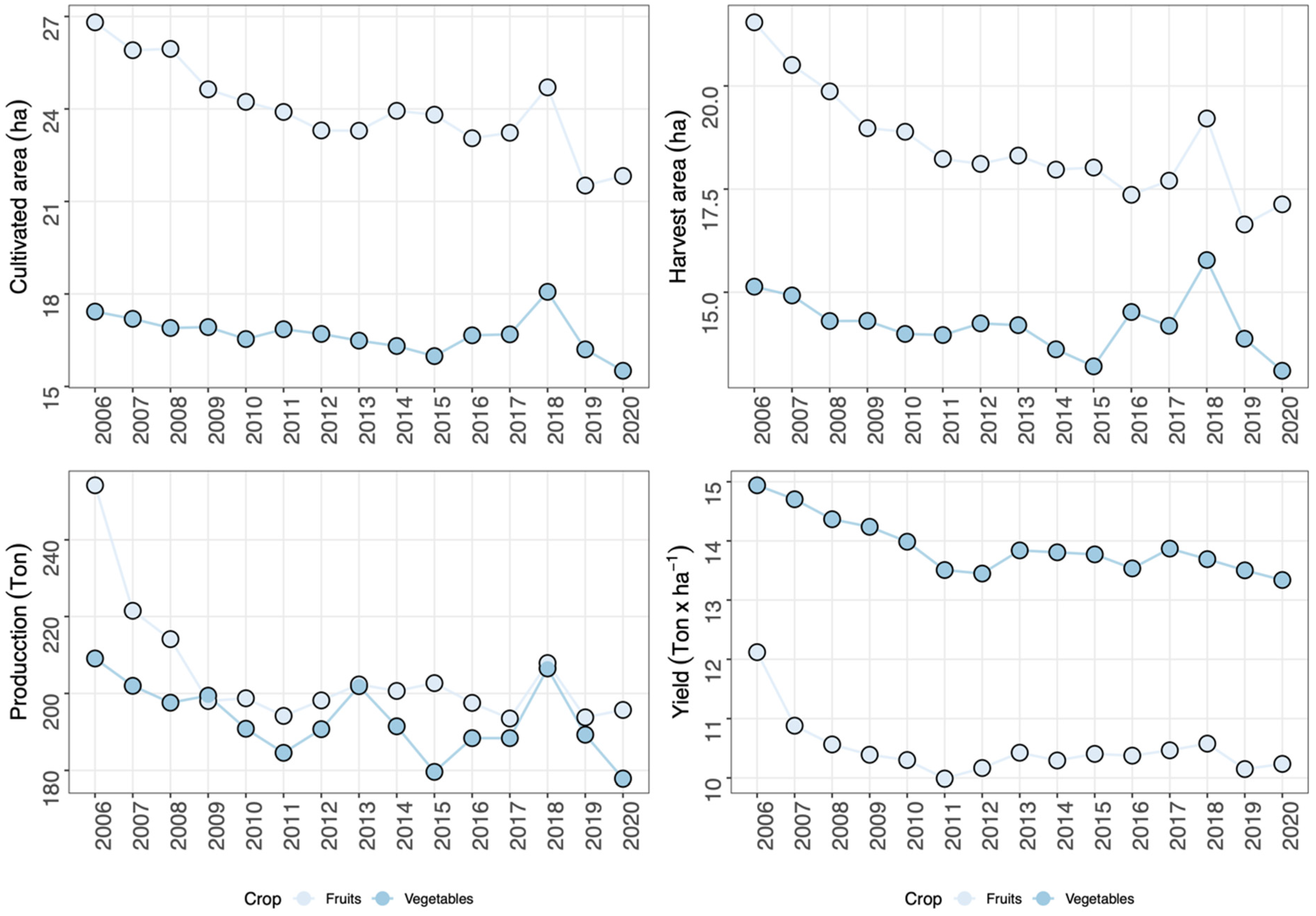
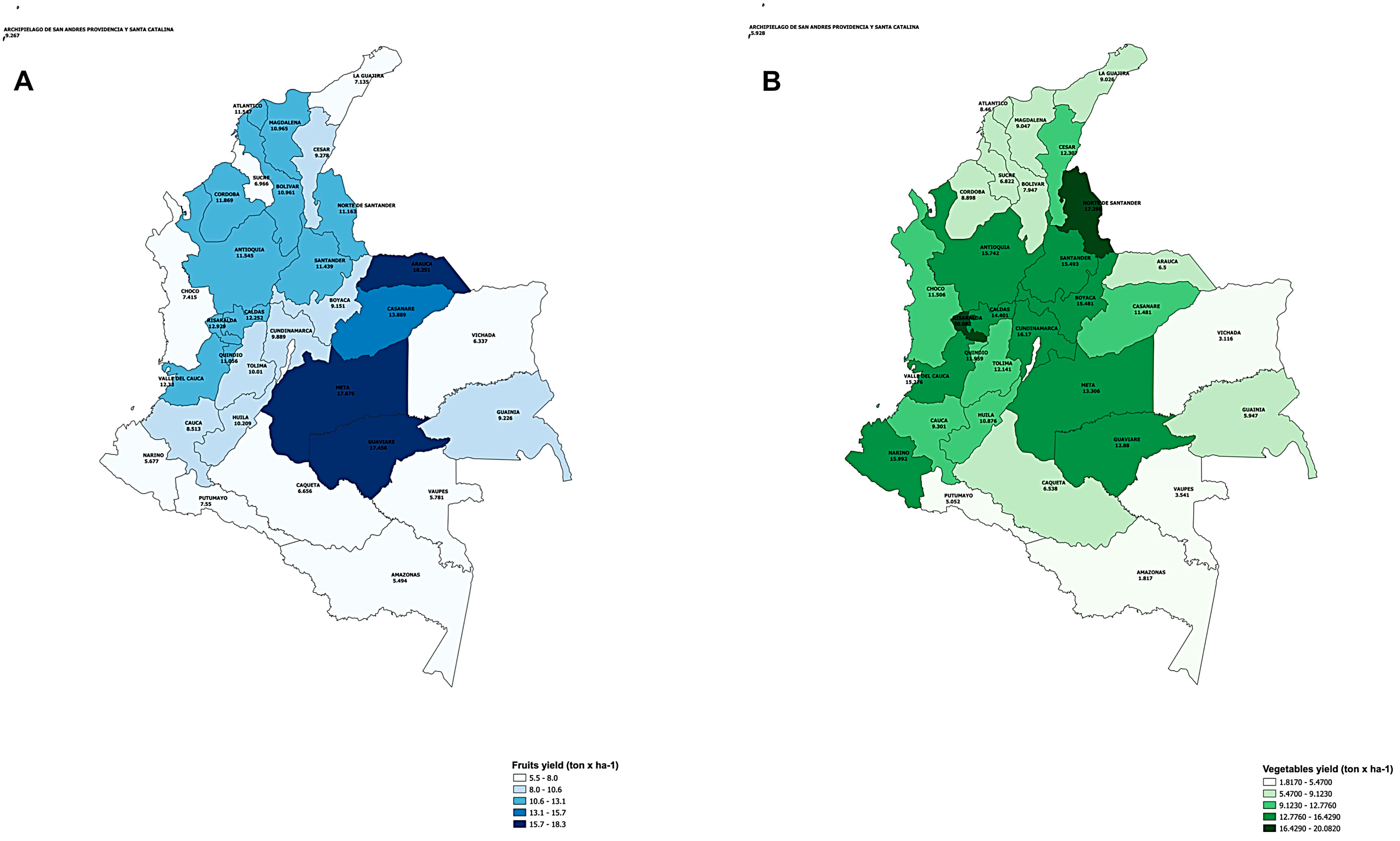

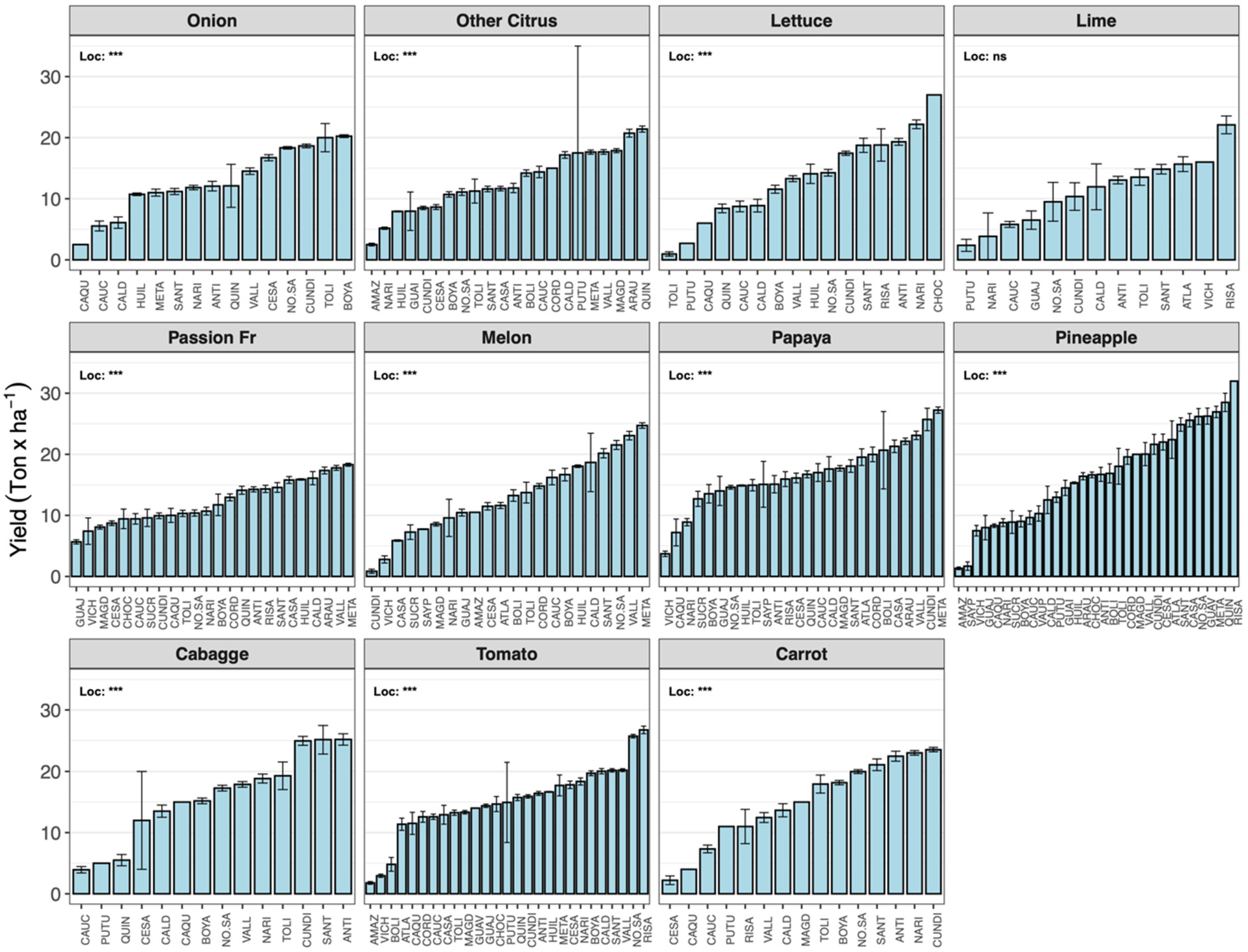
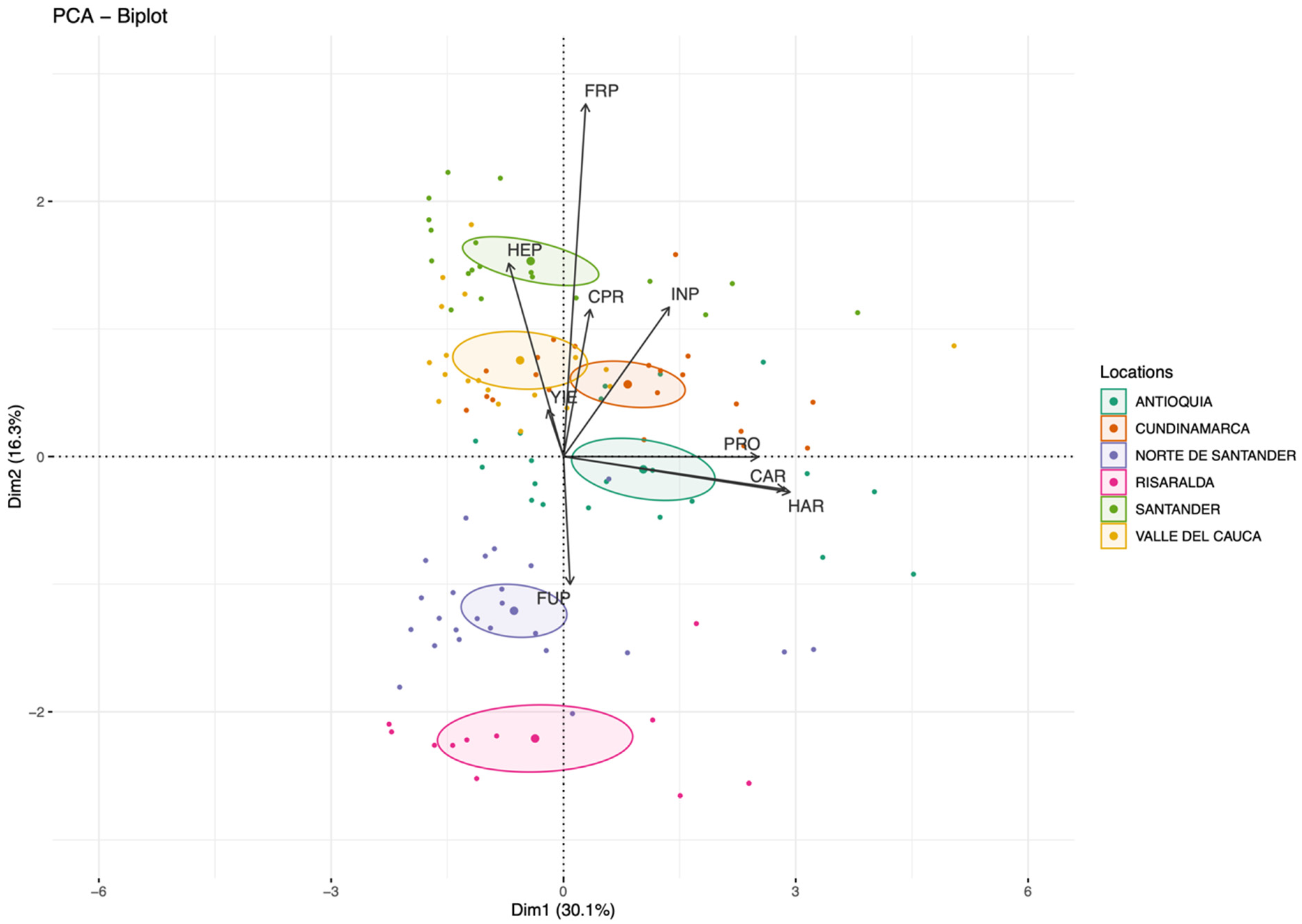
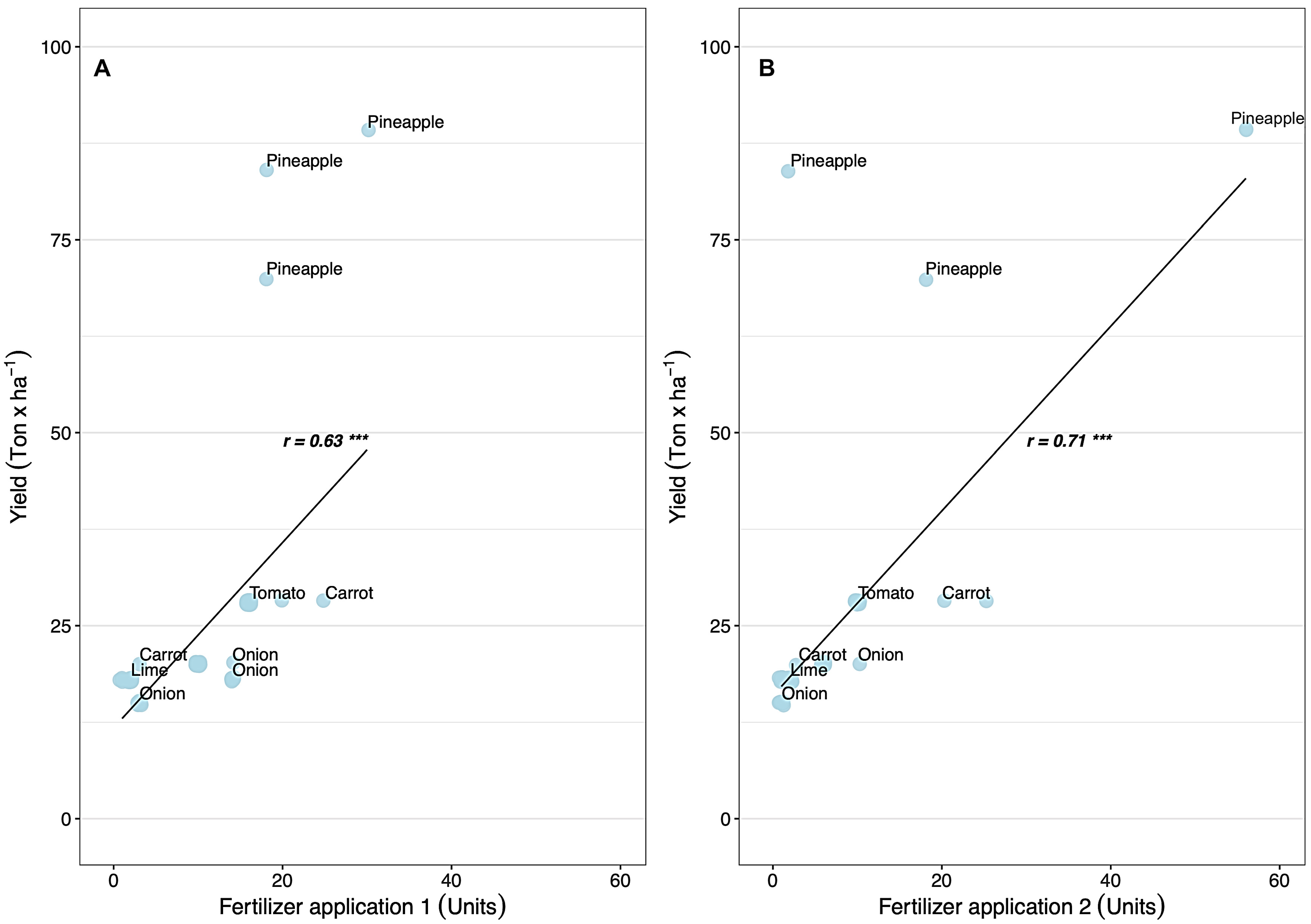
| Predictors | Carrot | Cabagge | Tomato | Onion | Lettuce | Papaya | Pineapple | Passion fr | Melon | Lime | Other Citrus | |||||||||||
|---|---|---|---|---|---|---|---|---|---|---|---|---|---|---|---|---|---|---|---|---|---|---|
| Antioquia | - | - | - | - | 14.92 | *** | - | - | 8.32 | ns | 12.24 | ns | 16.04 | *** | - | - | - | - | - | - | 8.77 | *** |
| Arauca | - | - | - | - | 6.74 | ns | - | - | - | - | 19.27 | ** | 15.75 | *** | 3.16 | ** | - | - | - | - | 17.70 | *** |
| Atlantico | - | - | - | - | 9.83 | *** | - | - | - | - | 16.70 | * | 21.35 | *** | - | - | 2.91 | ns | 2.47 | ns | - | - |
| Bolivar | - | - | - | - | 3.20 | ns | - | - | - | - | 17.91 | * | 16.46 | *** | - | - | 4.21 | ns | - | - | 11.18 | *** |
| Boyaca | −4.34 | *** | −10.02 | *** | 18.15 | *** | 8.17 | *** | 0.56 | ns | 10.65 | ns | 8.16 | *** | −2.38 | * | 7.99 | ns | −12.86 | ns | 7.61 | ** |
| Caldas | −8.84 | *** | −11.69 | *** | 18.55 | *** | −5.96 | *** | −2.13 | ns | 14.73 | * | 11.94 | *** | 1.66 | * | 9.68 | ns | −1.71 | ns | 14.09 | *** |
| Caqueta | −18.37 | *** | −10.07 | ns | 10.25 | *** | −9.55 | * | −5.00 | ns | 4.35 | ns | 7.49 | *** | −4.49 | ns | - | - | - | - | - | - |
| Casanare | - | - | - | 11.58 | *** | - | - | - | - | 18.44 | * | 24.54 | *** | 1.44 | * | −4.76 | ns | −8.07 | ns | 8.62 | *** | |
| Cauca | −15.18 | *** | −21.31 | *** | 11.07 | *** | −6.55 | *** | −2.26 | ns | 14.15 | * | 9.57 | *** | −4.94 | *** | 7.37 | ns | −7.24 | * | 11.42 | *** |
| Cesar | −20.37 | *** | −13.29 | * | 16.20 | *** | 4.63 | *** | −8.50 | ns | 13.24 | ns | 22.19 | *** | −5.73 | *** | 2.33 | ns | - | - | 5.41 | * |
| Choco | - | - | - | - | 13.18 | *** | - | - | 16.00 | ns | 15.96 | *** | −4.68 | * | - | ns | - | - | - | - | ||
| Cordoba | - | - | - | - | 10.97 | *** | - | - | - | - | 17.12 | * | 19.13 | *** | −1.47 | * | 5.61 | ns | 2.14 | ns | 12.37 | ** |
| Cundinamarca | 1.05 | ns | −0.26 | ns | 14.34 | *** | 6.57 | *** | 6.45 | ns | 22.84 | ** | 20.95 | *** | −4.37 | *** | −8.34 | ns | −2.43 | ns | 5.45 | * |
| Guainia | - | - | - | - | - | - | - | - | 14.19 | *** | - | - | - | - | - | - | 4.77 | ns | ||||
| Guaviare | - | - | - | - | 11.89 | * | - | - | - | - | 25.75 | *** | - | - | - | - | - | - | - | - | ||
| Huila | - | - | - | - | 15.16 | *** | −1.35 | ns | 3.08 | ns | 12.03 | ns | 14.61 | *** | 1.50 | ** | 9.09 | ns | - | - | 4.93 | * |
| La Guajira | - | - | - | - | 12.85 | *** | - | - | - | - | 11.17 | ns | 6.64 | ns | −8.73 | *** | 1.68 | ns | −5.92 | ns | - | - |
| Magdalena | −7.93 | ns | - | - | 11.80 | *** | −1.13 | ns | - | - | 14.83 | ** | 21.39 | *** | −6.29 | *** | −0.24 | ns | - | - | 14.87 | *** |
| Meta | - | - | - | - | 16.08 | *** | −0.25 | ns | - | - | 24.37 | ** | 26.45 | *** | 3.93 | *** | 14.08 | * | - | - | 14.64 | *** |
| Nariño | 0.56 | ns | −6.35 | *** | 16.83 | *** | - | - | 11.19 | ns | 6.03 | ns | 8.15 | *** | −3.64 | *** | −0.51 | ns | −8.58 | ns | 2.20 | ns |
| Norte de Santander | −2.52 | ** | −7.95 | *** | 24.20 | *** | 6.27 | *** | 3.26 | ns | 11.73 | ns | 25.79 | *** | −3.94 | *** | 12.94 | * | −3.35 | ns | 7.83 | ** |
| Putumayo | −11.81 | * | −20.33 | ** | 13.61 | ** | - | - | −8.30 | ns | 7.08 | ns | 12.23 | *** | - | - | - | - | −10.05 | * | 14.18 | ** |
| Quindio | 2.63 | ns | −19.56 | *** | 14.29 | *** | −0.02 | ns | −2.58 | ns | 13.86 | ns | 27.03 | *** | −0.28 | ns | - | - | - | - | 18.40 | *** |
| Risaralda | −11.45 | *** | −0.36 | ns | 25.29 | *** | - | - | 7.80 | ns | 13.11 | ns | 32.01 | *** | 0.10 | ns | - | - | 8.96 | *** | - | - |
| San Andres y Providencia | - | - | - | - | - | - | - | - | 12.24 | ns | 1.56 | ns | −13.85 | * | −2.03 | ns | - | - | - | - | ||
| Santander | −1.38 | ns | −0.04 | ns | 18.68 | *** | −0.89 | ns | 7.75 | ns | 15.22 | * | 24.08 | *** | 0.28 | ns | 11.32 | * | 1.87 | ns | 8.53 | *** |
| Sucre | - | - | - | - | - | - | - | - | - | 9.85 | ns | 8.55 | *** | −4.87 | *** | −1.59 | ns | - | - | - | - | |
| Tolima | −4.53 | *** | −5.91 | ** | 11.76 | *** | 7.97 | ** | −10.05 | ns | 12.04 | ns | 17.63 | *** | −3.97 | *** | 4.97 | ns | 0.74 | ns | 7.95 | ** |
| Valle del Cauca | −10.05 | *** | −7.32 | *** | 18.71 | *** | 2.45 | * | 2.29 | ns | 20.23 | ** | 19.74 | *** | 3.42 | *** | 14.47 | ** | 2.14 | ns | 14.66 | *** |
| Vaupes | - | - | - | - | 3.58 | ns | - | - | - | - | - | - | 9.57 | *** | - | - | - | - | - | - | - | - |
| Vichada | - | - | - | - | 1.49 | ns | 37.36 | - | - | 0.88 | ns | 6.58 | ** | −6.86 | * | −5.28 | ns | 3.36 | ns | - | - | |
| Year | 0.14 | 0.12 | 0.40 | 0.04 | 0.00 | 0.08 | 1.51 | 0.18 | 1.46 | 1.75 | 0.35 | |||||||||||
| Residual | 54.10 | 66.20 | 54.20 | 37.36 | 50.49 | 50.85 | 46.79 | 33.69 | 50.74 | 58.38 | 29.99 | |||||||||||
| r2 | 0.24 | 0.22 | 0.21 | 0.28 | 0.26 | 0.33 | 0.43 | 0.24 | 0.33 | 0.17 | 0.47 | |||||||||||
Disclaimer/Publisher’s Note: The statements, opinions and data contained in all publications are solely those of the individual author(s) and contributor(s) and not of MDPI and/or the editor(s). MDPI and/or the editor(s) disclaim responsibility for any injury to people or property resulting from any ideas, methods, instructions or products referred to in the content. |
© 2024 by the authors. Licensee MDPI, Basel, Switzerland. This article is an open access article distributed under the terms and conditions of the Creative Commons Attribution (CC BY) license (https://creativecommons.org/licenses/by/4.0/).
Share and Cite
Parra-Londono, S.; Tigreros, J.A.; Montoya-Correa, C.A. Colombian Crop Resilience: Evaluating National Yield Stability for Fruit and Vegetable Systems. Agriculture 2024, 14, 1546. https://doi.org/10.3390/agriculture14091546
Parra-Londono S, Tigreros JA, Montoya-Correa CA. Colombian Crop Resilience: Evaluating National Yield Stability for Fruit and Vegetable Systems. Agriculture. 2024; 14(9):1546. https://doi.org/10.3390/agriculture14091546
Chicago/Turabian StyleParra-Londono, Sebastian, Jaime Andres Tigreros, and Carlos Alberto Montoya-Correa. 2024. "Colombian Crop Resilience: Evaluating National Yield Stability for Fruit and Vegetable Systems" Agriculture 14, no. 9: 1546. https://doi.org/10.3390/agriculture14091546










